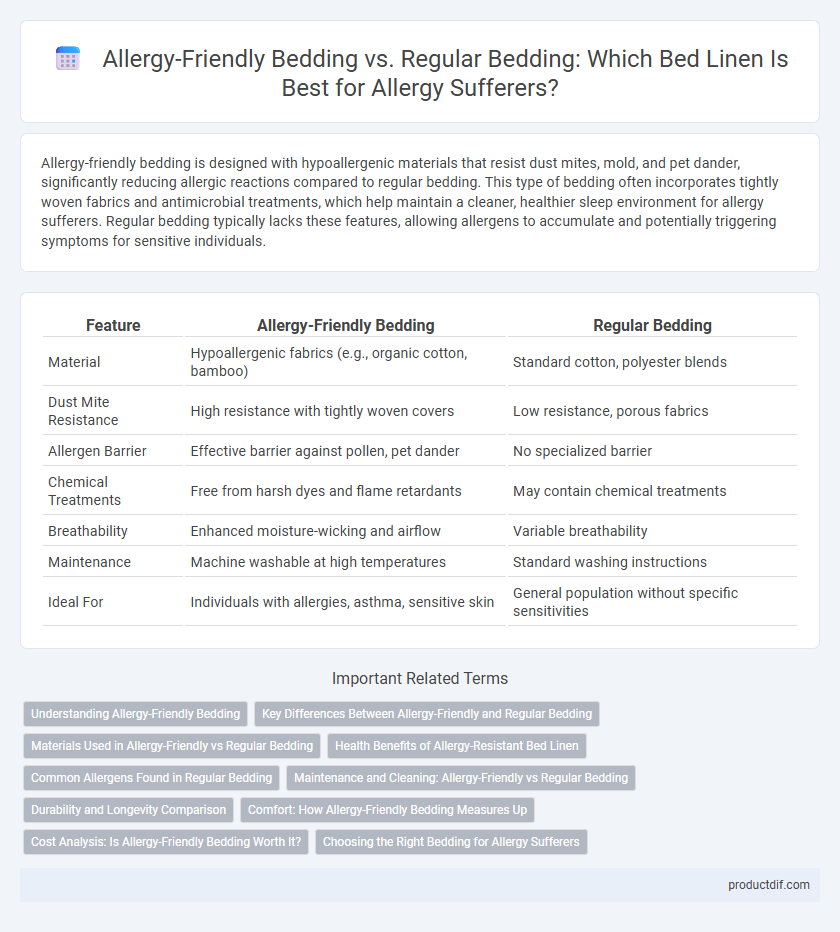Allergy-friendly bedding is designed with hypoallergenic materials that resist dust mites, mold, and pet dander, significantly reducing allergic reactions compared to regular bedding. This type of bedding often incorporates tightly woven fabrics and antimicrobial treatments, which help maintain a cleaner, healthier sleep environment for allergy sufferers. Regular bedding typically lacks these features, allowing allergens to accumulate and potentially triggering symptoms for sensitive individuals.
Table of Comparison
| Feature | Allergy-Friendly Bedding | Regular Bedding |
|---|---|---|
| Material | Hypoallergenic fabrics (e.g., organic cotton, bamboo) | Standard cotton, polyester blends |
| Dust Mite Resistance | High resistance with tightly woven covers | Low resistance, porous fabrics |
| Allergen Barrier | Effective barrier against pollen, pet dander | No specialized barrier |
| Chemical Treatments | Free from harsh dyes and flame retardants | May contain chemical treatments |
| Breathability | Enhanced moisture-wicking and airflow | Variable breathability |
| Maintenance | Machine washable at high temperatures | Standard washing instructions |
| Ideal For | Individuals with allergies, asthma, sensitive skin | General population without specific sensitivities |
Understanding Allergy-Friendly Bedding
Allergy-friendly bedding features tightly woven fabrics such as microfiber or tightly woven cotton that create a barrier against dust mites, pet dander, and other common allergens. These bedding products often incorporate hypoallergenic materials that resist mold and bacteria growth, improving sleep quality for allergy sufferers. Compared to regular bedding, allergy-friendly options reduce exposure to allergens and help minimize allergic reactions and respiratory issues.
Key Differences Between Allergy-Friendly and Regular Bedding
Allergy-friendly bedding is designed with hypoallergenic materials such as organic cotton or bamboo and features tightly woven fabrics that prevent dust mites, mold, and pet dander accumulation, unlike regular bedding which often uses standard materials that can harbor allergens. The key difference lies in the antimicrobial and dust mite-resistant properties of allergy-friendly bedding, which significantly reduce allergic reactions and respiratory issues. Regular bedding typically lacks these protective qualities, increasing exposure to common indoor allergens that can trigger symptoms.
Materials Used in Allergy-Friendly vs Regular Bedding
Allergy-friendly bedding typically uses tightly woven fabrics such as organic cotton, bamboo, or microfiber that act as barriers against dust mites, pollen, and pet dander, unlike regular bedding which often includes materials like polyester or untreated cotton that allow allergens to penetrate. Hypoallergenic materials in allergy-friendly bedding are treated to resist mold, mildew, and bacteria, reducing the risk of allergic reactions. In contrast, regular bedding materials may retain moisture and allergens, creating an environment conducive to irritants and allergens.
Health Benefits of Allergy-Resistant Bed Linen
Allergy-resistant bed linen is designed with hypoallergenic materials that inhibit dust mites, mold, and other common allergens, significantly reducing allergic reactions and respiratory issues. These fabrics often feature tightly woven threads and anti-microbial treatments that prevent the accumulation of allergens, promoting healthier sleep environments for allergy sufferers. Choosing allergy-friendly bedding can improve overall sleep quality and reduce symptoms such as sneezing, itching, and congestion compared to regular bedding.
Common Allergens Found in Regular Bedding
Common allergens found in regular bedding include dust mites, pet dander, mold spores, and pollen, which can accumulate in pillows, mattresses, and sheets, triggering allergic reactions and respiratory issues. Allergy-friendly bedding uses tightly woven fabrics and hypoallergenic materials designed to resist these allergens, reducing exposure and improving sleep quality. Regular bedding often lacks these protective features, increasing the risk of allergen buildup and related health problems.
Maintenance and Cleaning: Allergy-Friendly vs Regular Bedding
Allergy-friendly bedding requires frequent washing at high temperatures to eliminate dust mites, allergens, and bacteria, often using hypoallergenic detergents suitable for sensitive skin. Regular bedding may not withstand such intensive cleaning, as frequent high-heat washing can degrade fabrics and cause color fading. Proper maintenance of allergy-friendly bedding extends its lifespan while ensuring a healthier sleep environment compared to standard bedding that carries a higher risk of allergen buildup.
Durability and Longevity Comparison
Allergy-friendly bedding often features hypoallergenic materials such as tightly woven cotton or microfiber, which resist dust mites and allergens while maintaining durability over time. These specialized fabrics typically undergo treatments that enhance their longevity, preventing wear and tear compared to regular bedding made from standard cotton or polyester blends. Consequently, allergy-friendly bedding delivers sustained comfort and hygiene without sacrificing durability through repeated washing and daily use.
Comfort: How Allergy-Friendly Bedding Measures Up
Allergy-friendly bedding offers enhanced comfort by using hypoallergenic materials that reduce irritation and promote better sleep quality for sensitive skin. Unlike regular bedding, it resists dust mites, mold, and allergens, creating a cleaner and more breathable sleeping environment. These properties help maintain consistent comfort levels, especially for allergy sufferers or individuals with respiratory conditions.
Cost Analysis: Is Allergy-Friendly Bedding Worth It?
Allergy-friendly bedding typically costs 20-40% more than regular bedding due to specialized materials like hypoallergenic fibers and dust-mite resistant covers designed to reduce allergens. Studies indicate that investing in allergy-friendly bedding can lower allergy symptoms and improve sleep quality, potentially reducing medical expenses related to allergies over time. While initial costs are higher, the long-term health benefits and reduced allergy treatment costs often make allergy-friendly bedding a cost-effective choice for allergy sufferers.
Choosing the Right Bedding for Allergy Sufferers
Allergy-friendly bedding uses hypoallergenic materials and often includes dust mite-resistant covers, significantly reducing common allergens compared to regular bedding. These specialized fabrics, such as tightly woven cotton or synthetic blends, prevent the accumulation of dust mites, pet dander, and mold spores that trigger allergic reactions. Selecting bedding labeled as hypoallergenic and washable at high temperatures ensures a healthier sleeping environment for allergy sufferers.
Allergy-Friendly Bedding vs Regular Bedding Infographic

 productdif.com
productdif.com